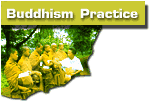MEDITATION
TECHNIQUES
The Buddha
taught many ways of investigating the nature of mind and body.
A look through the monastery and meditation centre descriptions
will give you an idea of the meditation systems practiced in
Thailand. Ideally, meditation should begin from the first moment
of awakening in the morning until the last moment before sleep at
night. Besides the classic postures of sitting, walking,
standing, and lying down used in meditation, one can
also perform such activities as eating, talking, washing
clothes, taking a bath, and using the toilet with equal
care and mindfulness. An experienced teacher or "good friend"
will be valuable for any student. Meditation techniques
fall into the broad categories of either samatha (calm)
or vipassana (insight), though some of one will generally
be present with the other.
Samatha
Development of samatha techniques can lead to increasingly
focused states of mind until the mind becomes one-pointed
or absorbed in jhana states. Concentration can be developed
from anapanasati (mindfulness with breathing), from
visual objects, and from mantras (repetition of phrases). The traditional
list contains 40 objects of meditation; you can read
about them in The Path of Purification (Visuddhi Magga)
translated by Nanamoli Bhikkhu and in other books. The
Buddha recommended mindfulness with breathing as being suitable
for everyone to establish and develop concentration. Other objects
of meditation can be useful in our lives too.
Metta (loving kindness) generates feelings of goodwill
and happiness toward ourselves and other beings; metta
practice serves as an antidote to ill-will and fear.
Meditation on the parts of the body none of which is
attractive in itself results in a lessening of attachment to our
own bodies and those of others; a reduction of sensual desires occurs;
another benefit is that unpleasant sensations can be more easily
endured. Meditation on death, when properly done, brings to mind
the body's impermanence and lack of ownership; a person who practices
this will always be watchful and, at life's end, die without fear
or confusion.
Vipassana
Once some concentration has been developed, the mind
can be turned to observation of the physical and mental
factors that rise and fall in one's consciousness. Through
continued practice, the Three Characteristics of anicca
(transitory nature of all conditioned phenomena), dukkha (inherent
unsatisfactoriness of all conditioned phenomena), and
anatta (no permanent, abiding self can be found in any
conditioned phenomena) will become deeply known. As the mind directly
experiences these truths, the desires and attachments that cause
so much suffering begin to drop away. Even a little vipassana practice
can bring greater wisdom and peace to our lives.
THE FOUR NOBLE TRUTHS
We can experience these truths, which lie at the heart
of the Buddha's teachings, through direct experience.
They can be viewed as
(1) Diagnosis of an illness;
(2) Prognosis;
(3) Recovery; and
(4) Medicine to cure the disease.
The first 2 truths deal with the way things are; the
last 2 point the way to freedom from suffering.
1. The Noble Truth of Suffering
Besides "suffering," other translations of
the Pali word dukkha include unsatisfactoriness, dis-ease, and instability.
All these words point to the fact that no conditioned
phenomenon can provide true (lasting) happiness in our
lives. The first step in a spiritual life is to look very closely
and honestly at our experience of life and see that there
is suffering. We tend to overlook or ignore or just blindly react
to the unpleasant, so it continually haunts us. Yet
although physical suffering is a natural aspect of our
lives, we can learn to transcend mental suffering.
2. The Noble Truth of the Cause of Suffering
Through a lack of understanding of how things truely
exist, we create and recreate an independent self entity called
"me."
The whole of our experience in life can be viewed through
this sense of self. In consequence, various cravings
govern our actions. Cravings arise for sense experiences,
for "being" or "becoming" (e.g. rich, famous,
loved, respected, immortal), and to avoid the unpleasant. These
cravings are the root cause of suffering.
3. The Noble Truth of the Cessation of Suffering
The mind can be purified of all the mental defilements
that cause suffering. Nibbana, the ultimate peace, has
been compared to the extinction of a three-fold fire
of lust, ill-will, and delusion. One who has realised
cessation has great purity of heart, ocean-like compassion, and
penetrating wisdom.
4. The Noble Truth of the Way to the Cessation of Suffering
The Way leading to cessation contains a thorough and
profound training of body, speech, and mind. Traditionally
it's outlined as the Noble Eightfold Path: (1)
Right Understanding; (2) Right Intention; (3) Right Speech; (4)
Right Action; (5) Right Livelihood; (6) Right Effort; (7)
Right Mindfulness; and (8) Right Concentration. On the level of
morality (sila), the Path entails restraint and care in speech,
action, and livelihood. The concentration (samadhi) level
requires constant effort to abandon the unwholesome
and develop the wholesome, to increase mindfulness and clear comprehension
of the mind-body process, and to develop mental
calm and stability. The wisdom (panna) level entails
the abandonment of thoughts of sensuality, ill-will, and cruelty;
ultimately it penetrates the true nature of phenomena
to see impermanence, unsatisfactoriness, and impersonality.
When all 8 factors of the Path come together in harmony to
the point of maturity, suffering is transcended. In summary, the
Four Noble Truths can be thought of as that which is to be
(1) comprehended, (2) abandoned, (3) realized, and (4)
developed.
|

